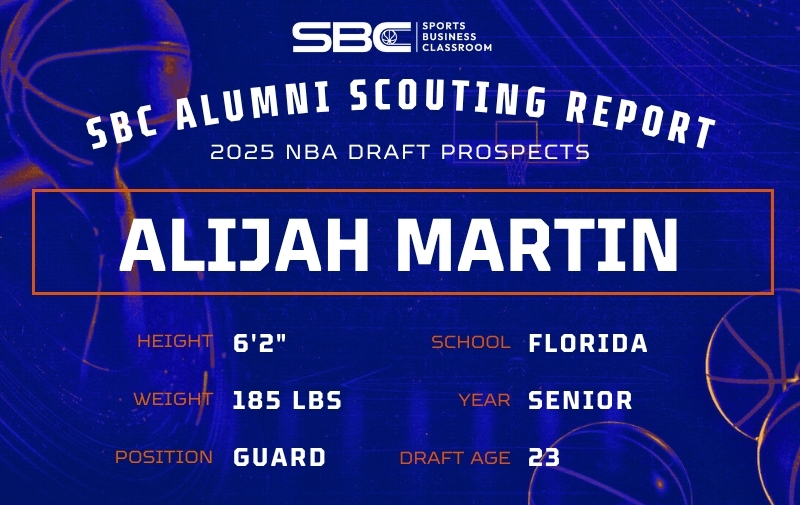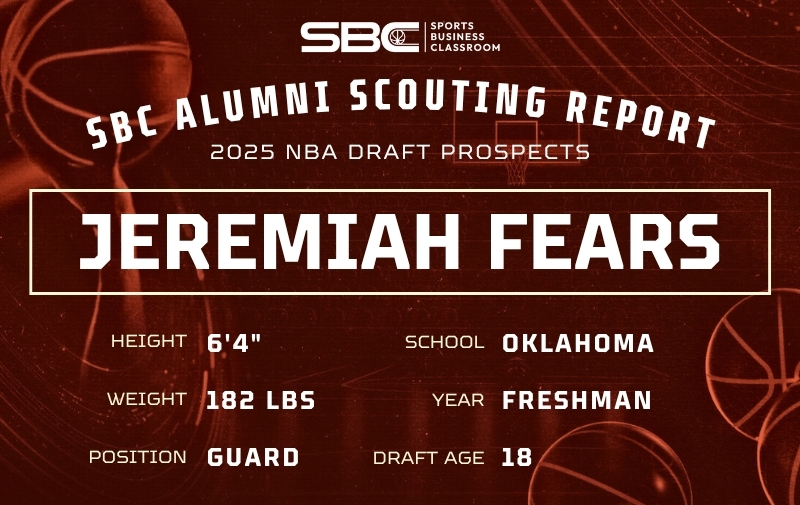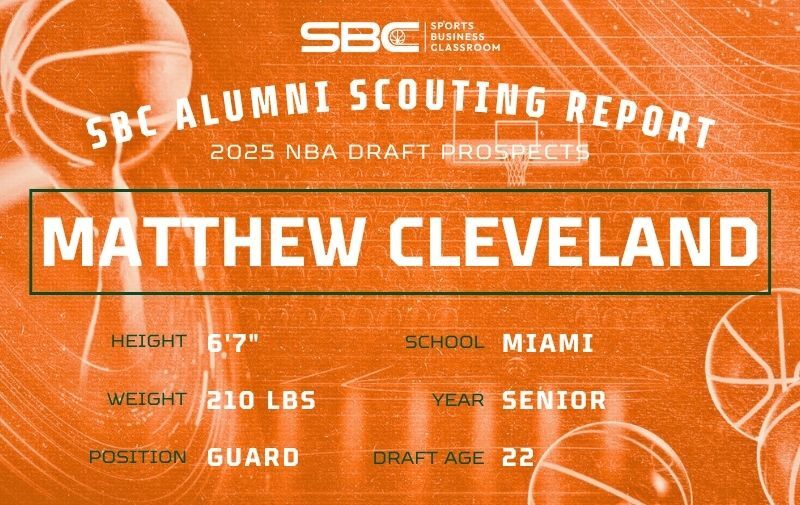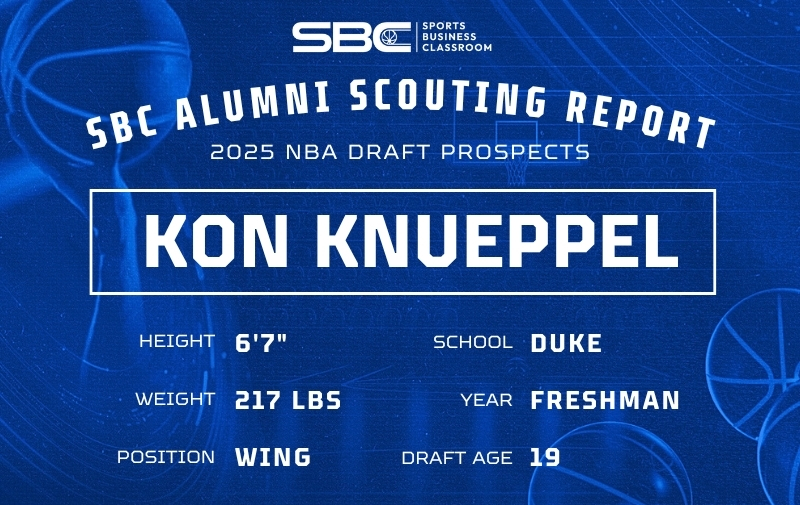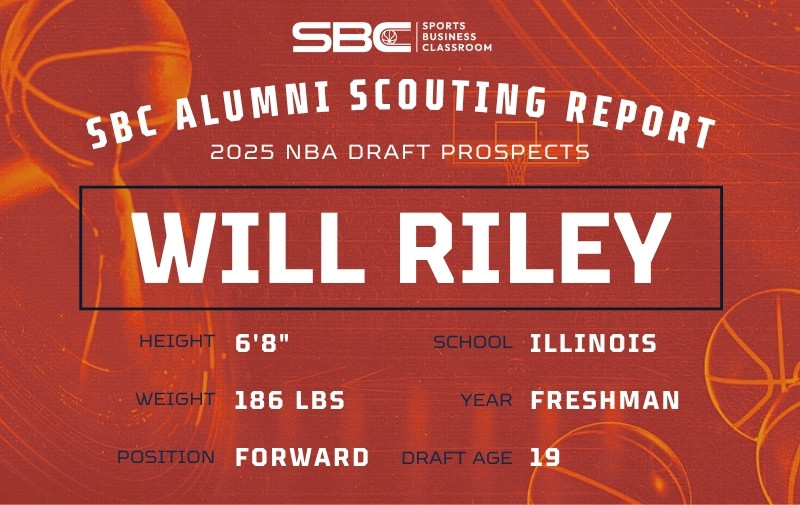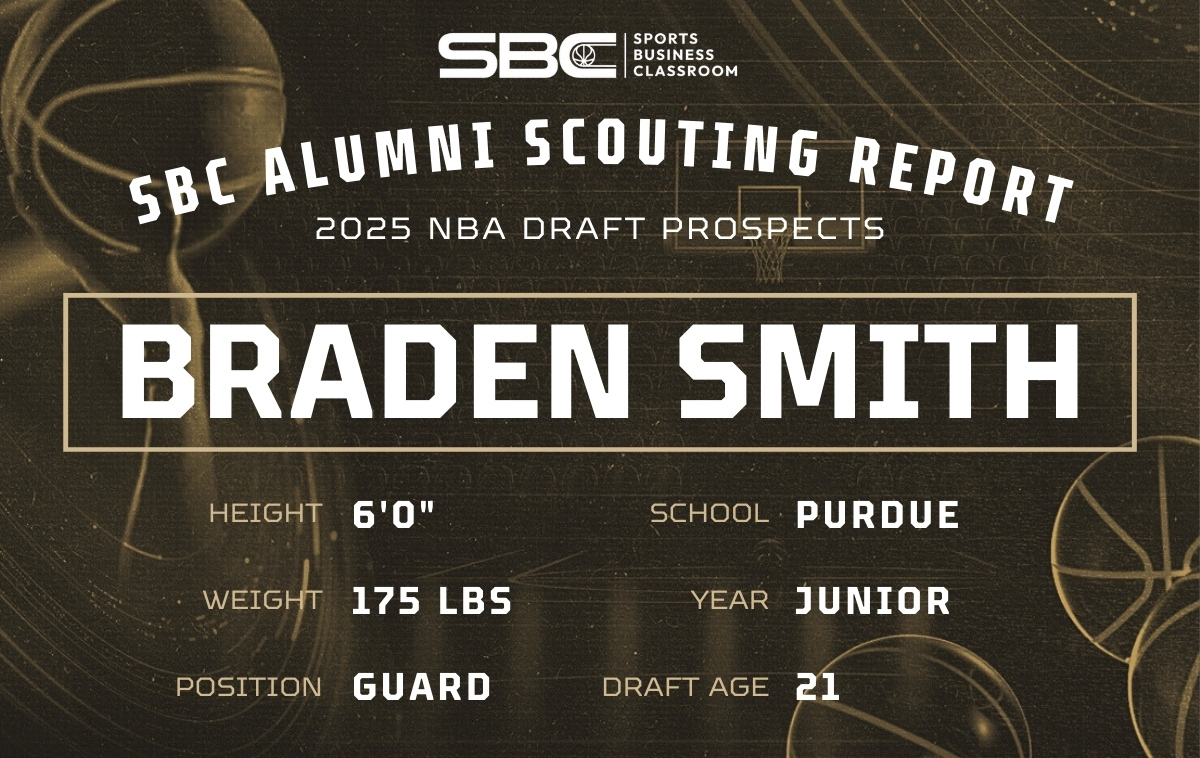
[The following scouting report is part of a series on potential 2025 draft prospects from Sports Business Classroom alumni.]
Braden Smith
Frame: 6’0″, 175 lbs
Position: Guard
Team: Purdue Boilermakers
2025 Draft Age: 21
Stats via www.sports-reference.com
Offense
Smith’s calling card is his ability to run an offense. He currently leads the nation in assist percentage at 45.9 percent and is fourth in assists per game at 8.5. After Zach Edey’s departure, Smith has seen his role in the offense increase, yet he has shouldered the burden gracefully thus far into his junior season. Always playing at his pace, Smith is seldom rattled, keeping his dribble alive at all times and rarely forcing an issue. When he doesn’t see a clear advantage for his team, he will pull the ball out to reset the offense or call another play.
Smith is an excellent entry passer, using all sorts of fakes and angles to get the ball where his bigs want it. Smith excels as a pick-and-roll ball handler, typically snake dribbling the ball screen where he can survey the court with his defender on his back to find an open man. Whether that be the big rolling, open shooters on the strong or weak side, Smith can make all sorts of passes, such as hitting cross-court passes with his left hand or dump-offs to cutters. Smith does not let the ball stick, only having a 23.6 usage rate. He passes the ball immediately upon finding an open man and will make an extra pass to get his offense a better look. In transition, he gets the ball up quickly, either dribbling himself or hitting the hit-head man, typically creating an open shot, either at the rim or even tossing it back to a shooter trailing. Smith can do this while keeping the ball largely safe, averaging 2.7 turnovers per game and a turnover percentage of 19.5 percent.
Another significant component of Smith’s game is his three-point shooting. He shoots 42.6 percent on 5.5 attempts per game while being assisted on 46.2 percent of these shots, and he is a lifetime 41.1 percent shooter on 292 attempts. Smith has a quick trigger on his three-point shot and almost exclusively hops into it off the dribble. This pairs particularly well when he gets a good ball screen and can come off it and hop into his shot. Smith has a compact form with a high release that Smith follows through consistently. He has range on his shot and is a threat to pull up when given any space. He is capable of coming off of screens or shooting off the catch.
Smith can pair his probing and snake dribbles with stop-and-go’s and change-of-pace moves to fake defenders and give himself space to shoot mid-range shots (35.3 percent on long twos while being assisted on 25 percent of attempts). He hit 40.1 percent from this range last year, suggesting the heavier load could be to blame. However, plenty of games remain to see if this balances out. His touch and form translate to these looks. He is occasionally capable of hitting driving fadeaways with defenders on him, but this is tougher for him when matched with more physical opposition. He has a nice floater with his right hand when attacking drop coverage, and it is a shot Smith can go to more, as he unselfishly passes up good looks (possibly too often).
An area of concern for Smith has always been his ability to finish and get to the rim. He’s converting 52.4 percent on 21 attempts while being assisted on 27.3 percent of these shots. Due to his size and lack of burst, Smith struggles to beat more athletic defenders to finish in traffic. He prefers using his right hand to score and typically only shoots layups with a clear lane, either by faking out the big man or cutting to the rim. Smith has flashed some nice finishes with his left hand, particularly in transition, but not enough to rely on at the next level. As a result of this low output at the rim, he rarely gets to the free-throw line despite being a great shooter, currently shooting 88.5 percent on 26 attempts.
Defense
Smith is best as an off-ball defender with concerns about size and athleticism. His motor allows him to keep lesser ball handlers in front of him and even make plays on the ball. He does a good job sliding his feet to get in front of players. However, Smith doesn’t have the tools to guard more prominent perimeter players. He can get beat off the dribble or hit by a ball screen that he struggles to recover from, often switching onto the big man, where he does a good job fighting to ensure they don’t get a pass or offensive rebound. This may not be sustainable in the NBA, as professional guards will see the mismatch, and bigs will make themselves available for a high-percentage shot.
Oftentimes, Smith is used off the ball. He is not necessarily a good off-ball defender, but he doesn’t hurt Purdue either. Occasionally, he will pick off cross-court pass attempts or kick-outs to his man. Averaging 2.0 steals per game, with a steak percentage of 3.4 percent this season, both are career-highs. He is susceptible to falling asleep off-ball, especially when hit with flare or backdoor screens, which create high-quality looks for the other team. He must overcome that at the next level, especially given his defensive shortcomings and size disadvantage.
Looking Ahead
Smith is currently in the conversation for the best point guard in the nation, with his ability to facilitate and shoot from behind the arc, and he always seems to generate a quality shot for himself or others. However, his size and athleticism hamper his ability to get to the rim and finish, as do his defensive capabilities.
Smith projects as a backup point guard in the NBA. He has a relatively high floor and low ceiling. He projects to be selected in the 50s or potentially signed as an undrafted free agent.


